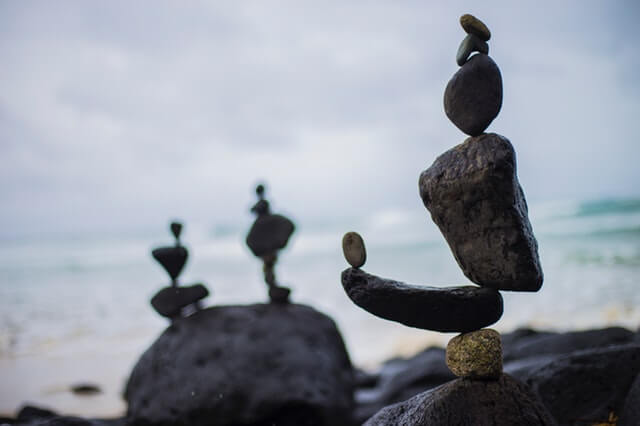Try these three Feldenkrais exercises to improve your balance.
The older you get, the more likely you are to fall and hurt yourself. Statistically speaking, it’s just a fact. And falling while turning is much more likely to lead to a hip fracture than falling when walking in one direction. However, perhaps the most unfortunate part of this fact is that the fear of falling is often the cause of falling.
As we age, we compensate for our declining balance by restricting movements, leaving one vulnerable to limited activity diseases such as cardiovascular disease, obesity, osteoporosis, and stroke. Also, low levels of activity change how quickly we can react to outside forces and move to regain balance, aka, known as balance reflexes. With each fall, we become more fearful, thus increasing chances of falling again, and on and on, the cycle continues.
It’s a vicious progression, but with the help of the Feldenkrais Method, anyone can regain their confidence (and thus their balance). If you want to improve your balance, these three Feldenkrais exercises are an excellent starting point.
Exercise #1: Chair and Blanket
For the first exercise, you will need a chair and a blanket. If you can sit in front of a mirror for this exercise, you can see your body in action, but it is not necessary. First, roll up the blanket and place it on the chair. Sit straddling the blanket roll as though you were riding a horse. If your chair has a backrest, be sure to sit forward on the seat, so you are not touching it.
With both feet resting on the ground and starting with an upright spine, allow one sit bone to sink toward the floor. Feel how the other sit bone lifts from the blanket roll. Let your abdominal muscles relax, and your breathing be free and easy. Your spine will curve or bend to the side as you perform this movement. Repeat this movement slowly at least ten times per side. Can you notice something new each time as you do the lifting movement: which foot pushes a little more into the floor, which foot gets lighter, can the top of the head tip toward the lifting sit bone, can the jaw and eye muscles be a little softer; can you sense the space between the teeth? For more of a challenge, try doing the movement with your eyes closed.
Exercise #2: Walk the Line
The next exercise is from our Integral Human Gait class. Stand up. Imagining a straight line extending in front of you, place one foot directly in front of the other, and walk forward for about five to ten paces, whatever is most comfortable for you. Let your arms be free. It is not necessary that you use a “heel to toe” walking pattern, in fact, don’t! Start first with noticing what is your usual distance between the two feet. How confident do you feel walking along the line? Turn around, repeat, but intentionally narrow the gap between your feet, allow the feet to come closer to your imaginary line. Now turn around, repeat, but this time see how wide the distance can be between the two feet as you walk the line. Repeat the narrow and wide experiment two or three times. Now let it all go and walk the line without thought of narrow or wide distance between the feet. What do you notice? How confident do you feel now?
If you want to make this exercise even more challenging, try it with your arms crossed over the chest and your hands resting somewhere on your shoulders. Let the trunk turn a little left and right. Can you be less rigid? Are you holding your breath? Remember, however, that safety is always our primary concern. If you need something to hold onto lightly, walk down a hallway so that a wall is on either side of you.
Exercise #3: Walk Barefoot
We wear shoes so much that none of us know just how much they can hinder our balance. The feet and ankles function best when they are free. Why? Because special receptors in the joints and muscles play a pivotal role in letting the brain know where we are in space. All the bones and muscles need to be able to move unhindered to access their full potential. When you wear shoes, we constrain, and with restriction, these receptors, muscles, and bones can grow weak because of lack of stimulation. By simply walking around the house barefoot, even for short distances or time frames, you are exercising all the little parts of your feet and ankles, helping them grow more reliable and more reactive that can stimulate and improve your balance reflexes.
Interested in Learning More about Balance, Reflexes, and Movement? Contact Me Today.
Get in touch with me today to learn more about the online and clinic classes that I offer.

